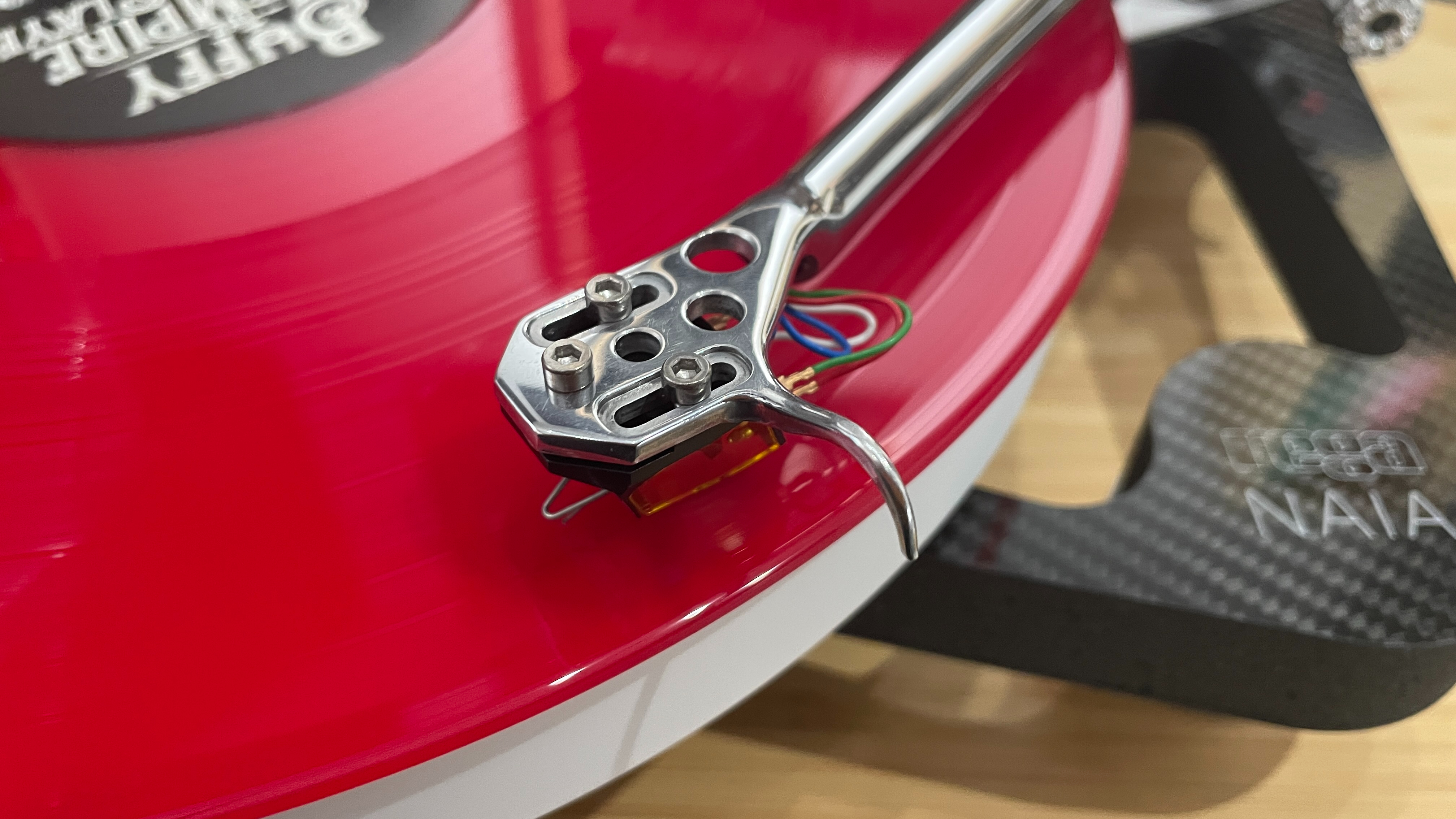What Hi-Fi? Verdict
The Naia is an exceptionally capable record player that sets a sky-high standard for resolution and transparency
Pros
- +
Exceptional clarity and detail resolution
- +
Transparency and naturalness
- +
Brave styling
Cons
- -
Sonic presentation appeals to the head more than the feet
- -
The foam edges on the plinth look a little unfinished
Why you can trust What Hi-Fi?
The Naia is the best turntable Rega knows how to make. Its roots go back to 2009 when the company embarked on a research and development project that aimed to push its core engineering beliefs of low mass and high rigidity to the limits. No compromise was allowed, as this was a cost-no-object exercise that was never intended to be put on sale. That meant it could be designed purely for maximum performance using the most exotic materials and no regard to how it could actually be put into production. The result was the legendary Naiad turntable. But there was a problem; people wanted to buy it.
At first, Rega resisted the idea, but such was the interest that it was forced to put the Naiad into a limited production run of 50 units. These were handmade and so awkward to build that only three people in the factory were considered skilled enough to do it, including the CEO Phil Freeman, a watchmaker by trade. The Naiad’s price? Yours for around £30,000.
Rega considers the Naia the production-ready version of the Naiad. The original plan was to design a deck that bridged the performance gap between the Naiad and the existing Rega Planar 10 turntable, but that changed when the company found the new design could be developed to match the range-topper’s performance.
Build & Design

After reviewing the Planar 8 and Planar 10 turntables, we’re familiar with Rega’s distinctive skeletal plinths, but this design still looks outlandish. It is surprisingly small and light, and in the case of the new Naia features a Tancast 8 foam core sandwiched on either side by Graphene-impregnated carbon fibre. The foam reduces the transmission of vibrations while the carbon fibre skins help rigidity. The area between the arm base and main bearing is further strengthened by the use of ceramic braces, forming a stressed beam assembly that avoids energy absorption without increasing mass too much. Rega firmly believes that ‘mass absorbs energy and lost energy equals lost music’.
The Naia’s main bearing assembly is special. Both the central bearing and the spindle are made from a composite ceramic material called ZTA (Zirconium Toughened Alumina), which is known for its hardness and resistance to abrasive wear, making it ideal for this job. Rega claims this to be the most accurate and long-lasting main bearing assembly it has ever produced. The spindle sits in the middle of a beautifully machined aluminium sub-platter, which is something of a work of art. It is a shame this part is hidden once the ceramic main platter is in place.

Type Belt drive
Operation Manual
Speeds 33⅓, 45 RPM
Speed change Electronic
Cartridge Aphelion 2 moving coil
Phono stage? No
Bluetooth? No
USB? No
Dimensions (hwd, with dust cover) 12.5 x 42 x 35cm
Weight 4.65kg
Finishes x 1 (black)
Rega has used ceramic platters for years now, valuing their rigidity. This is also one of the few components where the brand’s engineers prefer to add mass. The Naia’s platter is shaped on the underside so that most of its mass is concentrated around the perimeter to help the flywheel effect and improve speed stability. A trio of round-sectioned belts connect the deck’s 24V motor and sub-platter. Rega spent three years researching and developing rubber compounds for its belts and has achieved a level of consistency and accuracy that it is proud of. Why three belts? The 2.6kg weight of the Naia’s ceramic platter requires these for a quick start-up and any microscopic differences between the three belts are levelled out, helping speed stability.
The Naia’s motor is a 24V low-noise design controlled by an outboard power supply. This power unit is housed in a functional-looking half-width box and offers electronic switching between 33⅓ and 45RPM. The supply’s internal circuitry uses DSP and a high-stability crystal to ensure that the motor gets a clean and precise power feed with each unit specifically adjusted for its partnering motor during the manufacturing process to minimise vibrations.
The latest hi-fi, home cinema and tech news, reviews, buying advice and deals, direct to your inbox.

Rega makes big claims for the Naia’s RB Titanium tonearm. Its shape may be entirely familiar but, as the name makes clear, it now makes extensive use of titanium rather than aluminium. The change of material and redesigned bearing assembly have resulted in a lighter and stiffer design. We love the shiny finish, but it is the precision and low friction movement of the bearings that impress the most.
It is possible to buy the Naia without the factory-fitted Aphelion 2 moving coil cartridge for £9999 / $12,995 / AU$19,999, but the two go so well together that we would be tempted to buy the complete package. The Aphelion 2 sits on top of the Rega cartridge tree. It has a graded black anodised aluminium body and a boron cantilever with a fine-line ‘nude’ stylus. We have long been fans of the company’s three-point mounting arrangement that ensures that its own cartridges are perfectly aligned in the headshell. It is such a fuss-free arrangement we wish more companies would follow suit. Rega thoughtfully supplies a torque wrench to ensure the cartridge isn’t over-tightened into the headshell, so avoiding any damage.

The Aphelion 2 tracks well at the recommended 1.9g downforce and has no issues working into our reference Cyrus Phono Signature phono stage. We have no doubt that Rega’s high-end Aura MC phono stage would deliver even better results.
Sound

As we start the testing process, just for fun we place the Aphelion 2’s stylus on the record but don’t start the motor. We turn up the volume level on our amplifier and (very) lightly tap the support and part of the plinth just to hear what kind of resonances the deck generates. It turns out that the Naia’s rigid yet light construction means it is excellent at dealing with low-level external vibrations. We hear a quick thud that quickly dissipates. Trying the same thing with our reference Technics SL-1000R (a high mass, heavily damped, direct drive design) is eye-opening with that initial thud louder and lingering for longer. It is accompanied by a surprising amount of higher-pitched ringing from the deck’s structure. Hardly the most scientific of experiments admittedly, but it strongly suggests that Rega’s light and rigid approach has plenty of merit. Even so, as with any record player, if you want to get the most from this deck, place it on a rigid, low resonance support that's positioned well away from your speakers.
A source at this level demands top-class partnering equipment. Along with the aforementioned Cyrus phono stage, we have a moving coil-equipped Burmester 088/911 MkII pre/power combination driving either ATC’s SCM 50 or Wilson Benesch’s A.C.T. 3Zero floorstanders. The system’s cables are a mixture of premium offerings from Chord Cables and Vertere Acoustics.

We have had plenty of experience with Rega’s turntables and as we move up the price points from the entry-level Planar 1 through the Planar 3 and ending with the Planar 10, it is clear that each step up the range has a less obvious sonic character. They become more transparent and put less of an imprint on the recording. This process reaches its obvious conclusion with the Naia, which is essentially the purest representation of the company’s engineering philosophy to date.
Those expecting sonic fireworks from the Naia/Alphelion 2 are in for a disappointment. While the first few rungs on the Rega ladder excel at sounding more entertaining and exciting than most of the competition, this range-topper isn’t that kind of product. It prefers to step quietly into the background leaving the recording to take the spotlight. The Rega sounds clean and crisp, delivering class-leading levels of information without ever edging into sterility.

This is very much an expert music-making machine. It has us gripped regardless of whether we listen to something grand like Beethoven’s Ninth Symphony or the more intimate music of The Carpenters. On orchestral works, it renders an expansive soundstage that displays an impressive degree of depth and focus. There is plenty of air around instruments and a wonderful lack of clutter in the presentation, no matter how complex the music gets. The Rega sounds as composed and controlled as they come yet retains the fluidity that many highly resolving rivals lack.
There is plenty of scale to the sound too, and for all its agility and articulation there is a good dose of authority when the music demands. Sometimes when a component sounds fast and responsive it is because it lacks low-end weight and power. That isn’t the case here, as a comparison with our Technics SL-1000R/Kiseki Purpleheart MC proves. Superficially, the Technics sounds more muscular, but it doesn’t take long to figure out that the Rega is significantly better with low-frequency transients, delivering them with greater heft and power while also revealing that the Technics has a slightly sludgy quality in comparison. Elsewhere, we love the natural way this Rega player renders instrumental textures and can convey low-level dynamic shifts with such conviction. It sounds authentic and honest.

The Carpenter’s Best Of collection proves that the Naia can shift down a gear effortlessly, delivering Karen Carpenter’s pristine vocals with considerable skill. There’s delicacy here and a real sense of force when needed. Tonally, things are as even as you like in our set-up, with the Aphelion 2 sounding balanced and ever so detailed.
Complaints? The Naia is an exceptional performer in most ways but its otherwise admirably off-hand approach to music-making did leave us wanting more in the way of rhythmic drive. As we listen to Michael Jackson’s Smooth Criminal, we’re deeply impressed by the Rega’s ability to organise the dense instrumentation into a wonderfully cohesive and musical experience, yet still find ourselves questioning whether it should make more of the song’s hard-charging momentum. Don’t get us wrong, this package is certainly surefooted and confident when delivering rhythm tracks, but compared to a rival like Vertere Acoustics MG-1 MkII/Mystic it does sound a bit polite and subdued in comparison.
Verdict

Even so, there is no denying that the Rega Naia is a magnificent achievement. It is as insightful and natural-sounding a record player as we’ve heard and manages that through truly ambitious single-minded engineering. It is clearly one of the best high-end record players available at this level and a must-listen for anyone interested in knowing just how good vinyl can sound.
SCORES
- Sound 5
- Build 5
- Features 3
MORE:
Read our review of the Vertere Acoustics MG-1 MkII/Mystic
Also consider the SME Synergy
Read our Technics SL-1000R review
Check our the best record players for every budget
What Hi-Fi?, founded in 1976, is the world's leading independent guide to buying and owning hi-fi and home entertainment products. Our comprehensive tests help you buy the very best for your money, with our advice sections giving you step-by-step information on how to get even more from your music and movies. Everything is tested by our dedicated team of in-house reviewers in our custom-built test rooms in London, Reading and Bath. Our coveted five-star rating and Awards are recognised all over the world as the ultimate seal of approval, so you can buy with absolute confidence.


